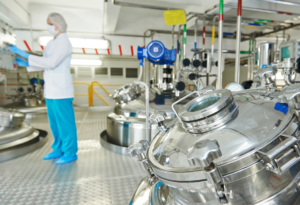How establishing a smart culture enables smarter, more efficient and sustainable operations
By David J. Mierau, PE, Managing Principal, Life Cycle Engineering (LCE)
As published in Contract Pharma
Sustainable manufacturing. Once seen as a “nice to have,” today it’s a business imperative. Pharmaceutical manufacturers can no longer operate without considering how their manufacturing process impacts the environment. Profitability doesn’t have to come at the expense of sustainability anymore. Not only can they co-exist, but sustainability can actually be your company’s cost-saving secret weapon.
If you’re running a plant today, your top priority is probably cost reduction. But to stay competitive in global commercial manufacturing you need to consider how sustainability can be factored into your manufacturing process. If you’re not seeing requirements or demand for sustainability in your current contracts, you’re likely to see them soon. Reducing greenhouse gas (GHG) emissions, increasing worker safety, ensuring the unimpeded flow of data, more transparency across supply chains and using less resources all seem like great goals; figuring out the most direct path to success for even one of these can be daunting. Even as sustainability moves toward becoming embedded in company strategy and ESG (Environmental, Social, and Governance) policy, many pharma manufacturers have yet to evaluate how they can effectively implement these practices.
Sustainable manufacturing isn’t just some lofty goal, only to be achieved with the latest clean technology or big investment in renewable energy. Those things may help move the needle, but you could take another approach. We call it smart culture—a systematic transformation where the people, processes, equipment and technology all work together. A smart culture can drive the productivity needed to reshape operations. With that comes an opportunity to be better—and do better—for both the environment and your bottom line.
Shifting to a new, sustainable way of operating
An uncertain economy, soaring energy costs, labor shortages, increased competition, inflation, and supply chain concerns—the pharmaceutical industry is facing the same challenges as many other industries. These aren’t new challenges, but their context has evolved. Manufacturing businesses are under constant pressure to deliver consistent products at lower costs, all while keeping productivity and reliability at an all-time high. Now, there is greater pressure put on the contract pharma industry to not just meet regulatory compliance, but improve their environmental performance as well.
While other industries are focused on meeting ESG targets, contract pharma has been slower to walk down the sustainability path. Cost reduction and compliance have taken the forefront over the years. Pharma manufacturers have leveraged their strengths around providing the industry with the right knowledge, optimized equipment and trained talent. Unlike other industries, consumers haven’t generally demanded that pharmaceutical products be made “greener.” But the industry is experiencing a shift in thinking. Investors are increasingly looking to ESG practices and as a result, many leading pharma companies have already made ambitious carbon neutrality and net-zero pledges.
Still, there’s a tendency to view sustainability in terms of cost instead of an investment. What’s good for the environment can also be good for business, but many innovative solutions and new technologies take years to show a return on investment. When we reframe the mindset and focus on making operations better, faster, cheaper, and safer, we can not only improve the bottom line, but experience the environmental benefits as well.
Digitization can only be successful when you start with the fundamentals
Digitization initiatives in the pharma industry have created tremendous opportunity to establish new levels of productivity, safety, and sustainability. However, the industry has seen mixed results—some efforts being abandoned while others succeeding. And while many companies are deploying digital technologies like AI, virtual reality, and data analytics, very few are effectively leveraging them. This all means that we may have the technology to help us build a better system and a greener future—but we aren’t really using it to the best of its ability.
Many companies are starting to pursue the digital route as the answer to their problems. You now have sensors on many of your machines, capturing and analyzing hundreds of data points every minute. But the question remains, what do you do with all that information? While data can successfully identify impending failures, many manufacturers fail to achieve their goals of improved asset reliability and reduced costs due to lack of management around data collection and reporting. Data quality related to asset management is critical. Bad data can lead to increased costs, poor decision-making and even lost revenue.
This is why establishing the right processes is critical. Instead of worrying about buying the latest piece of equipment, start with the fundamentals. Without the right business processes and data, it’s unlikely you’ll reach your goals. This could include developing standard operating procedures for ensuring and managing data quality. It could also be identifying individuals who are properly trained and certified to analyze the data. Many pharma companies are also creating digital teams that are a combination of data scientists and process experts. Some companies are even bringing in third party service providers to help analyze the vast amounts of technical information, understand fault codes and identify issues.
Thinking about sustainability? Think asset reliability
Pharma is a complex industry—multiple sites, different management processes, and a diverse asset mix. Businesses are under extreme pressure to get more value from their assets. But it may not always mean purchasing a new piece of equipment. Investing in agnostic software systems that can operate across various equipment manufacturers allows for greater access to preventative and predictive maintenance solutions. This can help inform data-driven decisions and improve quality, productivity and profitability. These programs can also lead to reduced energy consumption by ensuring the overall plant is operating at optimal efficiency—optimizing resources and reducing issues around bottlenecks in processes and temperature inaccuracies.
Manufacturers and facility operators often struggle to cost-effectively maintain safe and reliable operations for their critical assets. A huge portion of manufacturing operational costs are incurred by energy consumption. While your assets may be critical to running your operation, they’re often using more energy than needed. This is one of the key reduction areas contract manufacturers can focus on. With better asset management, you can lower energy usage, increase efficiency and drive productivity.
With asset performance management digital solutions, it’s common to track equipment energy consumption to help detect the early onset of failures. With this information, you have the needed baseline data to identify major energy reduction opportunities and trend progress toward energy improvement goals with trends over time.
If you want better sustainability, a smart culture is where you should start
Adopting the right tools and technologies can provide substantial benefits to the pharmaceutical manufacturing industry. Without technology the industry simply can’t tackle the growing pressure of streamlining business for better sustainability. Your journey to digitization may have already begun, but for long-lasting success you need to consider not just digital technology but your company’s overall operations. It may be time to create a smart culture.
So, what does creating a smart culture look like? It’s your fixed assets—the technologies you deploy, the work processes you follow, and your people. That means assets, processes, people, and technology. Digitization isn’t enough if you’re not planning for how your people will approach new ways of working. You may have engineers that have been operating the same way for decades, and now you’re informing them they have to change how they do things. How will you go about that and ensure employees remain engaged in the process? Education and training is a key part of success and is the golden thread of employee engagement. It can set the stage for the cultural change that must occur and build awareness of what operational excellence looks like within your plant. Only then can you achieve more efficient operations, reduce costs, and improve reliability.
How you go about implementing a smart culture is the next step. It starts with goal deployment followed by developing a roadmap to success:
- Begin with the end in mind and map out your current and future state. Maybe your goal is to reduce your energy consumption, which is one of the key actions companies can take in the energy-intensive manufacturing process. To do this, you need to know where you’re starting from—measuring and capturing your baseline. Establishing this process can often be the most challenging.
- Next, you should adopt best practices for better asset management reliability. Your plant may have several large sites with thousands of pieces of equipment, all operating at different times, and various business units all receiving different energy bills. This is where addressing your fundamental business processes comes into play. Ensuring your processes are aligned with your physical assets and organizational strategy is the only way you can make the bold changes needed to push the needle.
- Optimize the right technology to enable the monitoring needed to get to your goals, such as lower energy usage. This can also help offer clear, actionable insights, which will be key to your success. Focus on buying the technology that can add to your processes, like condition monitoring and asset performance management. When successfully implemented, these systems can operate across hundreds of different equipment manufacturers.
Future-proof your business by focusing on sustainability as the goal
The contract manufacturing industry is under constant pressure to compliantly produce more with less and do so safely and sustainably. Optimizing the performance of operations, driving greater ROI and ultimately shareholder value, is of top priority—but these things can’t come at the expense of the environment anymore.
Today there is greater opportunity than ever to leverage assets to establish new levels of sustainability. But in order to capture the opportunity, we need more emphasis on getting the fundamentals in place. Once you accomplish this, the promise of a smart culture can become a reality—where everything works together to produce exactly what we need.
You may already have the right equipment, data, and technology in place to help you build a better system. But the only way you’ll reach your goals is when your people and processes work together to drive greater efficiency and contribute to a greener manufacturing industry.
David J. Mierau works with global Life Sciences organizations to build world-class manufacturing operations through optimized asset management programs, and implement digitization with Industry 4.0 initiatives. Prior to LCE, David worked in pharmaceutical and biotech manufacturing as well as facilities/utilities equipment design.
















